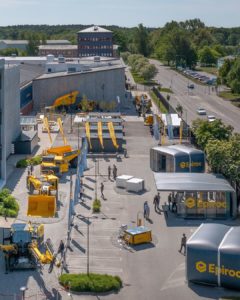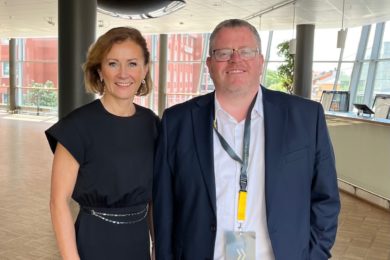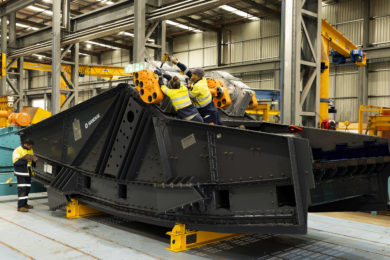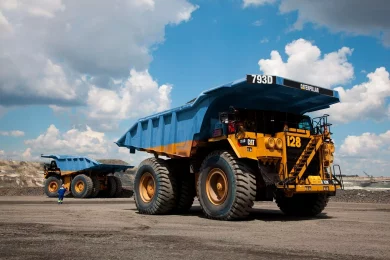During the Epiroc World Expo 2023, IM Editorial Director Paul Moore had the chance to sit down in person with President and CEO Helena Hedblom to talk through strengths and challenges as the industry begins arguably its most significant transition to date
You talk a lot to your major customers about their roadmaps – with clear emission reduction targets now having been set, is the mining industry becoming more collaborative and forward thinking and TCO focussed in terms of its relationship with key suppliers?
Very much so – I think our business has for some time moved away from being transactional to being more of a partnership, and this has just accelerated with the major technology trends. As to implement things like automation, digitalisation and electrification involves a lot of change on both sides from the skills needed by technicians and the competences needed to manage the technologies on a mine scale. It is all bringing us even closer to our customers and everything is also much more project-based – committing to automation for example takes at least a couple of years for a major implementation. We work very structurally with the customer as they embark on that journey. In the past if we developed a new technology, we could sell it to the customer and they could use it and benefit from it themselves – today we need to work together because we are taking bigger steps. Operators need to trust the new technology and rely on it first and foremost – and that’s where change management comes in, in both processes and ways of working.
The Epiroc World Expo 2023 was a unique opportunity to get an up to date insight into the innovations being applied across the OEM’s product lines, systems and technologies

Are there any elements of your approach to implementing new technologies you would highlight as being key to success?
I would first say that we do it in a very co-ordinated way with our largest manufacturing and R&D hub here in Örebro closely supporting the teams in our customer centers in the mining regions. We also make sure we get it right first at one or a few key sites. I like to say that for any new technology we tend to ‘nail it’ with one or two major customers before we are able to ‘scale it’ globally, all the time maintaining the structured methodology that allows it to be implemented in the most efficient way. I also think a big part of our success over the last five years is a more agile way of working when it comes to our product development and solving problems fast with the teams on the ground. We have three week intensive ‘sprints’ as an example. And increasingly this applies to software development, where this agile way of working has been the norm for many years now.
It is almost exactly five years since Epiroc was spun off from Atlas Copco and in that time you have outperformed the general stock market by a factor of two. What would you say is the most significant factor driving this?
To be a leader in technology you have to push the boundaries and I think we have done that and continue to do that. By that I mean leading in the technology shifts that are helping to shape the mining industry’s future. We also continue to grow the aftermarket which we have kept at about two-thirds of our business even as Epiroc has grown, and this has really helped us become a very resilient company in both margins and profit. We know our fleet on a very detailed level and how much we are selling in relation to every single machine and how much they are consuming. Also in the past we were mainly selling parts and hours in the aftermarket – today we like to say we are selling service offerings and products – anything from major upgrades to midlife services and even battery conversion. So we are selling the value rather than just the parts. This is highly appreciated by customers and also brings us closer to them. They know that they can rely on us and that if they opt for a rebuild, they know we will embed the latest technologies as part of it that will help give them achieve uplifts in productivity and safety without having to buy a new machine.
Looking at Örebro specifically – you have opened a new heat treatment facility for rock drills recently plus you have added an exploration drilling testing and competence center – are these indicative of a continued commitment to Örebro as your major manufacturing and R&D hub?
Of course – Örebro remains our largest site, and is home to the majority of our engineers. It is also where we manufacture our most advanced equipment. Beyond that the mining cluster we have in Sweden, including our long term partners and customers like Boliden, LKAB and Zinkgruvan, is significant as these mines are really at the forefront of new technology and making real the mine of the future through programs like SUM (Sustainable Underground Mining) and NEXGEN SIMS. This also has helped and continues to help us develop products for the global market. So Sweden and Örebro remain crucial to Epiroc’s evolution and development and therefore it is crucial for us to continue to ensure Örebro remains well positioned. Part of this is making strategic investments such as the ones you mentioned and we will continue to do this. I also want to mention people – we work a lot on making sure we continue to be an attractive employer for the younger generation; plus that we attract the right people to crucial roles like software and automation engineers, where we are competing with many other types of companies for the best talent.
Phil Goode, Chief Commercial Officer at RCT, now part of Epiroc, talking OEM-agnostic solutions at the Epiroc World Expo 2023

The industry is very much at an inflection point as regards electrification with a few trials and tests now being replaced by full fleet orders. Some companies have mentioned lead times as being an issue with BEVs – how are you ensuring Epiroc is fully prepared for the transition?
First of all on the batteries we have a very strong partnership with Northvolt which is really important on the supply side but also allowing us over time to take advantages of the latest battery cell technologies in mining quickly as they are also exposed to other industry verticals. Mining remains relatively small in battery terms compared to automotive and other markets. We have also readied the facilities in Örebro to make sure we have the ability to ramp up fast when we need to. But it also goes back into the design of the equipment – we have built up a full range of BEVs in a modular way – which will make it easier to scale up when volumes increase. We use the same batteries for all our machines with different modules and sizes depending on the machine load capacity and duty cycle. We have also made sure that our people have the right skills. Overall we are well prepared for the ramp up and this also means we are looking to use our global footprint in the best possible way – and that includes manufacturing capabilities in the US, China and India – so to some extent we are able to manage volumes across our sites to best fit where market demand is coming from. On logistics themselves, there have been issues with both air and sea freight over the last few years and we are not immune to that, but the situation continues to improve.
You have completed a lot of acquisitions since Epiroc was created – is there still room for transformational growth?
There remain plenty of opportunities in the technology space including close to our core business. We have made 23 acquisitions since the split and 27 since the split was first announced. Most of these support our growth strategy which broadly translates to us wanting to really be the leader in the major technology shifts as well as strengthening the aftermarket at the same time. There are some gaps in our portfolio in some niche areas which could still be closed but we have already addressed some of these, focussed on parts of the business where it would take longer for us to achieve the same result or products organically. A good example is AARD Mining Equipment in South Africa – bringing into Epiroc a number of new low profile equipment designs – plus it gave us a new manufacturing and assembly base in South Africa. But, of course the majority of our growth remains in house – in the past five years we have more than doubled our investment in R&D, and it is this that underpins most of our innovations.
Some of the key acquisitions involve OEM-agnostic offerings such as your 34% investment in ASI Mining and your recent acquisition of RCT. At Roy Hill you are automating a mixed fleet of large surface haul trucks which aren’t part of your traditional business. How important is that agnostic side of things going forward?
All of our main autonomous and digital solutions are OEM-agnostic – this has been part of our strategy for some years, which reflects the fact that there is not a single mine out there with only one brand, they are all mixed fleet. And even if there is one brand for drills, trucks and loaders, then you still have lots of other brands for utility and other vehicles. So if you are going to solve the productivity challenges in the mining industry we believe that you have to be OEM-agnostic. Taking automation, of course we started with automating our own equipment but this also gave us the knowledge of how to do it in a fast, reliable and efficient way. We saw an opportunity to take on a technology position that is broader than just our own equipment, so that is what we are doing. Ultimately there will be no Epiroc equipment solution and an OEM-agnostic solution in automation and digitalisation – there will just be one. All the equipment units a mine uses need to be able to communicate with each other from a safety and productivity standpoint. Ten or even five years ago, OEMs were primarily focused on their own machines which is natural, but over time and talking closely to customers, it is clear an agnostic solution is what they want and need and we have responded to that.
What role do you think AI is playing and will play in your business and products going forward? And on the flip side how do you make sure you still cater to the market that wants the more simplified equipment option?
It is already playing a vital role especially with regard to our products and trying to remove the human element from hazardous operational areas. But of course you need to ensure that the baseline is the machines and systems being at least as smart as when there is an operator in the cab. A good example is an underground loader – and making sure the machine is as good as the operator in selecting the right entry point to the muckpile and ensuring maximum filling of the bucket. Everything is becoming more data driven and the more data you have, the more intelligent the solutions are becoming. On different customer types, I see in the last three to four years the interest in new technology is across the board not just from Tier 1 miners and contractors. This is true in terms of region also – in the past Canada, Australia and the Nordic region tended to lead the way. Today it is happening across all regions at the same time. We are seeing a lot of BEV growth in Africa, for example, which is fantastic to see. But you are right there are many customers still waiting to see how new technology evolves – to be fast followers. They want to see the technology functioning well in their region. So that is very important for us – so that prospective customers in their own part of the world can see the new technology meeting KPIs as well as talk to operators and mine management before they are convinced. We have already developed the technology – we now need to ensure that it is implemented in the best way possible on behalf of not just the mine owners but also the operators, maintainers as well as our own service and support staff. Mines are mainly in remote places – we need to be sure we have the competences where they are needed. We have over 7,000 service technicians out there in the world, and their skill set will be the most important thing to ensure the technology will work 24/7. This is being done in a very structured and certified way. You can’t just develop a machine, produce it and sell it anymore. And of course we want to ensure we retain our aftermarket strength for these new machines. These machines are complex so if we can ensure they are well supported, in many cases we should also be able to enhance our aftermarket presence even further which all adds to the resilience of Epiroc as a company.
Does it help that most of the machines you make today already have advanced analytical capabilities and in many cases are also autonomous ready?
To be able to be automated, the machine needs our Rig Control System (RCS) in place. When I look at the number of units we have out there now equipped with RCS, it is far more than we actually have automated today. A lot of customers are not yet ready to go fully autonomous but instead have started with line of sight teleremote then to a controller cabin or office. You don’t often go straight from manual to full autonomy. But at least when they are ready to take all these steps, the machines themselves are ready – we just need to add the systems and processes, and operator training to ensure it happens in the safest and most efficient way. Also, a significant proportion of our installed base of machines is getting older and coming up for replacement – so this is a time when many of our customers are looking at the long term future for their fleets.










